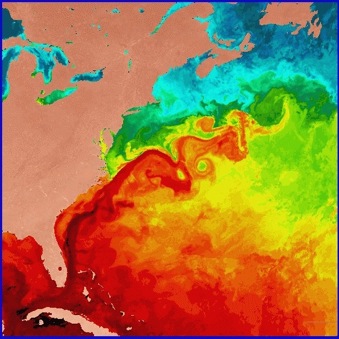OCE/MPO
603: Introduction to Physical Oceanography

Notes
1.
What is physical oceanography?
Physical
oceanography is the study of the fluid motions of the ocean.
It’s goal is to understand the processes (and their
significance) at all time and space scales, to simulate these
processes, and to make predictions if possible.
What
phenomena do physical oceanographers study? (e.g. surface and
internal waves, air-sea exchanges, turbulence and mixing,
acoustics, heating and cooling, wave and wind-induced
currents, tides, tsunamis, storm surges, large-scale waves
affected by earth's rotation, large-scale eddies, general
circulation and its changes, coupled ocean-atmosphere dynamics
for weather and climate).
What
external forces act on the ocean? (e.g. wind [waves,
turbulence, large scale waves, circulation], heating due to
the sun and geothermal energy, cooling, evaporation due to the
sun and wind, precipitation, tidal potential [the moon and
sun], earthquakes, gravity, friction).
What
internal forces act on the ocean? (pressure gradients,
viscosity or friction).
2.
Some important concepts
Physical
oceanography is a relatively young science.
Theory
of wind-driven ocean circulation dates to 1950’s.
Equations
for the motion of a turbulent ocean on a rotating sphere,
driven by variable winds and solar heating are unsolvable.
We need to make simplifying assumptions in order to
understand the ocean - but
most importantly we need observations.
Owing
to the size of oceans, and technological complexity and
expense of measurements, the ocean is under-sampled. Sampling
error is pretty much insurmountable in oceanography and can
lead to misleading hypotheses.
We
think we know the time-mean ocean circulation quite well, but
are only beginning to understand the time-varying ocean.
Satellite
data has revolutionized our understanding of surface ocean,
but lacks information about deep ocean (some inferred).
Reading:
JK1,
RS1-2
Last
modified: Sep 2016
Lecture
1: Course Overview: What is Physical Oceanography?
The
purpose of these webpages is to provide some notes and figures
and a link to the slideshow presentation made in class. The
notes are not comprehensive, and do not replace the required
readings. Much of these notes lean heavily on Lynne Talley’s
online material for SIO 210 at Scripps.
Link
to lecture 1 slideshow:1_introduction.pdf


